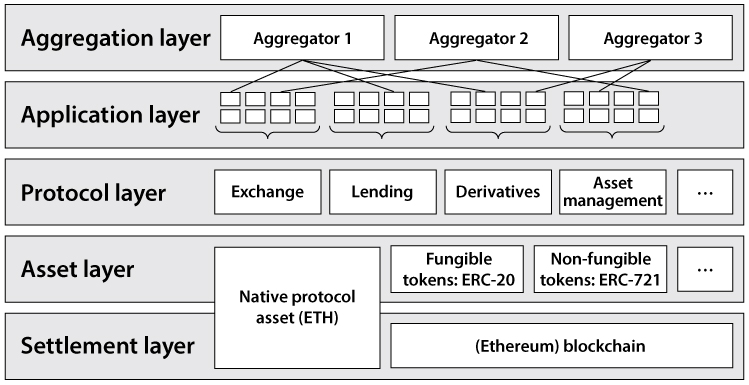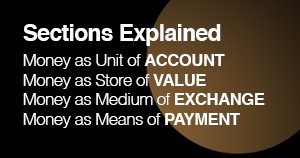Slowly but surely, an alternative financial infrastructure is being built, promising a cheaper, more efficient, stable and transparent way of lending and borrowing, issuing securities and managing money.
If that advert for decentralised finance (DeFi) sounds like it comes from the lips of a blockchain evangelist, think again: it’s the St. Louis Federal Reserve, one of the 12 regional offshoots of the US central bank, that says so.
In a new research paper authored by Fabian Schär of the University of Basel, the St. Louis Fed says that, if successful, DeFi could do away entirely with large chunks of the current financial infrastructure.
DeFi could do away entirely with large chunks of the current financial infrastructure
“This [DeFi] architecture can create an immutable and highly interoperable financial system with unprecedented transparency, equal access rights, and little need for custodians, central clearing houses, or escrow services, as most of these roles can be assumed by ‘smart contracts’,” Schär says in the paper.
According to the St. Louis Fed, DeFi relies on a hierarchical system, with a settlement layer at the bottom. For 90 percent of DeFi projects by value, ethereum acts as this foundational layer.
The next segment is the asset layer, where DeFi tokens—most of which follow an ethereum-based technical standard called ERC-20—are issued.
Above these two layers sit protocols, consisting of specific use cases such as exchanges, lending, debt markets, derivatives and asset management. Finally, there is an application layer and an aggregation layer, says the St. Louis Fed.
The architecture of DeFi

A key selling point of DeFi is its use of ‘smart contracts’ to replicate existing financial services in a more open, interoperable and transparent way, says Schär.
Smart contracts are applications stored on a blockchain and executed by a set of validators. If the underlying blockchain is open-access, as is the case with many cryptocurrency networks, any participant can verify the correct execution of any operation.
Although smart contracts are somewhat inefficient compared with traditional centralised computing, their advantage is a high level of security, says Schär.
“When implemented securely, smart contracts are highly transparent and minimise the risk of manipulation and arbitrary intervention,” he writes in the paper.
“DeFi has unleashed a wave of innovation,” he goes on.
“On the one hand, developers are using smart contracts and the decentralised settlement layer to create trustless versions of traditional financial instruments.”
“On the other hand, they are creating entirely new financial instruments that could not be realised without the underlying public blockchain. Atomic swaps, autonomous liquidity pools, decentralized stablecoins, and flash loans are just a few of many examples that show the great potential of this ecosystem.”
“DeFi has unleashed a wave of innovation”
An atomic swap is a financial transaction free of the settlement risk that ties up billions of dollars in capital for traditional financial institutions: in an atomic swap, both sides of a trade are executed in one indivisible transaction.
Autonomous liquidity pools underlie decentralised exchanges, decentralised stablecoins use cryptocurrency collateral to create tokens pegged to the value of fiat currencies like the dollar, and flash loans allow people to lend and borrow cryptoassets on an uncollateralised basis within a single blockchain transaction.
According to DeFi Pulse, around $37bn is currently locked up in DeFi smart contracts, a total that has risen sharply since the beginning of 2021 amidst the ongoing boom in cryptocurrencies.
Currently, the five most popular DeFi protocols, measured by the total value locked up, are three lending protocols—Maker DAO, Aave and Compound—and two decentralised exchanges, Curve Finance and Uniswap.
Although Professor Schär highlights the many possibilities of DeFi in the St. Louis Fed paper, he also notes its risks.
Any DeFi protocol is only as secure as the smart contracts underlying it, he says. And here, there’s an obvious informational asymmetry.
“Unfortunately, the average user will not be able to read the contract code, let alone evaluate its security,” writes Schär.
“While audits, insurance services, and formal verification are partial solutions to this problem, some degree of uncertainty remains.”
And the DeFi ecosystem already exhibits some worrying dependencies between various smart contracts and decentralised blockchain applications, says Schär.
“If there is an issue with one smart contract, it may potentially have wide-reaching consequences for multiple applications across the entire DeFi ecosystem,” he writes in the paper.
“Moreover, problems with the Dai stablecoin or severe ether/USD price shocks may cause ripple effects throughout the whole DeFi ecosystem.”
Last spring, during the coronavirus-related sell-off in cryptoassets, the Maker DAO protocol that underlies automated lending on the ethereum blockchain ran out of collateral, forcing a bailout by the programme’s operators. Dai is the dollar-pegged stablecoin used by the Maker DAO system.
And in recent days, congestion on the ethereum blockchain has risen to record levels, forcing per-transaction fees into triple figures and rendering many DeFi projects economically unviable.
Sign up here for the New Money Review newsletter
Click here for a full list of episodes of the New Money Review podcast: the future of money in 30 minutes
Related content from New Money Review









